FOR IMMEDIATE RELEASE – October 10, 2017
WASHINGTON – More than 20 million people in communities across the United States have more access to nutritious foods, physical activity, smoke-free environments, and/or clinical preventive services, thanks to a three-year grant funded project known as Partnering4Health®.
From 2014 to 2017, the Centers for Disease Control and Prevention provided five national organizations funding to work with 94 urban, rural and tribal communities for implementing sustainable changes that support healthy communities and lifestyles. Specifically, the project focused on fighting chronic diseases such as diabetes and heart disease, which are among the nation’s most costly health conditions. The initiative addressed issues such as exposure to secondhand smoke, access to healthy food and beverages, improved physical activity opportunities, and linking citizens to clinical and community supports.
A new report published by the five national organizations – American Heart Association (AHA), American Planning Association (APA), National WIC Association (NWA), Directors of Health Promotion and Education (DHPE) and the Society for Public Health Education (SOPHE) – summarizes the innovative changes made by communities to support healthier lifestyles where people live, work, learn and play.
“The outcomes of this initiative are far-reaching. The communities involved have access to environments that improve their well-being now, but also increased capacity to undertake other structural changes to that will improve health equity and benefit future generations.”
Elaine Auld, CEO of SOPHE.
The report, Partnering4Health®: National Organizations Empowering Communities to Improve Population Health, summarizes the community impacts:
- Residents of 74 communities now have more access to healthy food and beverage options sold at corner stores, vending machines, mobile food trucks, farmers markets, or by planting new community gardens.
- Residents of 36 communities have more opportunities for physical activity through the creation of bike-and walker-friendly spaces, strengthening school physical education, adding worksite wellness sites, and/or new shared use agreements that allowed public access to unused facilities, after-hours school gymnasiums or tracks.
- Those in six communities have more smoke-free parks, trails, college campus, stadiums or other environments.
- Mothers of young children in 29 communities can take advantage of breastfeeding-friendly businesses and better links to health care professionals and community resources to promote healthy lifestyles.
- More than 177 million media impressions reached the public about the community improvements and how to reduce their chronic disease risks.
“The new partnerships formed out of this initiative are living examples of systems change at the local level which serve as a foundation for other communities to emulate.”
Doreleena Sammons Hackett, executive director of DHPE
Twenty-nine of the NWA’s communities worked to improve community-clinical linkages. The local coalitions drew on WIC’s existing work in support of breastfeeding and services to establish strong referral networks; create lactation rooms; make “prescriptions” for non-pharmaceutical interventions; train healthcare providers and community partners on WIC benefits, breastfeeding, and cultural competency; and share tools and resources.
As part of the NWA project, Wichita Falls-Wichita County Public Health District (Texas) started a new farmers market at the local health department/WIC office to increase use of the farmers’ market nutrition program for WIC clients. The project resulted in $16,800 worth of fruits and vegetables in benefits for WIC clients over the age of one, and a 25 percent increase in voucher redemption rates for 2015.
Of APA’s 27 communities that worked to make streets safe, convenient and comfortable for users of all ages and abilities, 25 helped to make the community more walkable or bike-able, three expanded public access to sites such as gymnasiums during after school hours, and two increased physical activity opportunities for employees of local businesses.
To illustrate mobility and access issues that create barriers to walking and biking, one APA project provided 25 community leaders with wheelchairs to use for running errands. Making places wheelchair-friendly also makes them stroller- and walker-friendly. To illustrate barriers related to bicycling, the coalition invited community leaders to ride bikes alongside bicycling advocates.
AHA-funded communities worked to increase access to healthy food and beverages in public and county owned buildings, early childcare centers, hospitals and workplaces. The project also increased the number of mobile markets and the number of farmers markets accepting SNAP/EBT payments.
Twenty-three AHA communities helped residents be more active by developing or expanding shared use agreements, such as those with schools in Kanawha and Cabell Counties, and Huntington, West Virginia. A funded project In Beaverton, Oregon succeeded in getting all 33 elementary schools to include 10 minutes of physical activity during the day.
The Partnering4Health® report, a video with community testimonials, an online sustainability course and toolkit, a database with information about the 94 communities involved, infographics and advertising materials are archived on a website at www.Partnering4Health.org.
###

